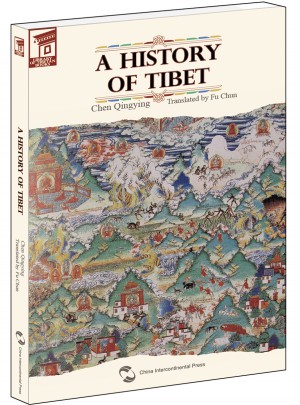

本套叢書從人文視角對西藏的歷史、宗教、文學、藝術、民俗進行精當展示,獨到解讀、描繪西藏風土人情和文化風貌,向國內外讀者展示西藏魅力。各分冊在內容上較多吸收了相關領域研究成果,注重講故事,雅俗共賞。 本書由著名藏學專家、中國藏學研究中心歷史所原所長陳慶英撰稿。全書清晰梳理了西藏歷史發展脈絡,特別是以歷史唯物主義的視角和方法,將西藏歷史各時期重大事件的背景、過程及影響,與西藏作為地方同中央的歸屬關系緊密聯系起來,用無可辯駁的史實證明西藏是中國固有領土和不可分割的組成部分。
《西藏歷史》介紹了西藏地區由古至今的發展歷史,全書分為十一章:吐蕃王朝建立前的西藏、吐蕃王朝時期的西藏、地方政教勢力割據時期的西藏、元代西藏、明代西藏、清朝前期的西藏、清朝后期的西藏、西藏人民反抗英國侵略的斗爭、民國時期的西藏、西藏的和平解放、西藏自治區的建立。本書以動態、發展的觀點,系統梳理西藏歷史社會曲折、復雜的演進變遷,很好地體現了愛國主義、民族團結、反對分裂的時代主題。書中精當利用歷史文獻、典籍、檔案資料等,真實展示了西藏歷史發展的許多重大事件,著重闡明了西藏歷史的一些關鍵問題及其依據:西藏自古以來是中國領土一部分;如何看待歷史上歷代中央王朝與西藏地方的關系;客觀評價歷代中央政府治藏政策的意義,等等。作為附錄,書中特別增加了“中央人民政府和西藏地方政府關于和平解放西藏辦法的協議”,用歷史進程中的關鍵去還所謂“西藏問題”的本真面目,頗見匠心。全書以史實證明西藏社會所經歷的從落后到進步,從封閉到開放,從政教合一到政教分離,從封建統治到民族自治,從傳統社會到現代化的歷史性轉折,澄清了所謂“西藏問題”的由來和實質,批駁了各種宣揚“西藏是一個國家”的謬論,揭露以達賴為首的“藏獨”分子以暴力方式破壞我國藏族地區的穩定、和諧、發展的局面的分裂本質。本書綱目線索清晰,內容充實扼要,吸收了西藏歷史研究的實證成果,引證論述嚴謹客觀,體現了作者的批判性思考。史論結合,言之有據,通俗易懂,又不失學術水準,體現了創新與探索。全書圖文并茂,制作精良,是一本了解西藏的上乘讀物,令人耳目一新。A History of Tibet introduces the development of the region ever since ancient times. It is composed of 11 chapters, including Tibet before Tubo Kingdom, Tubo Kingdom, Era of Fragmentation, Tibet in Yuan Dynasty, Tibet in Ming Dynasty, Tibet in Early Qing Dynasty, Tibet in Late Qing Dynasty, Resistance against British Aggression, Tibet in the Republic of China, Peaceful Liberation and Establishment of Tibet Autonomous Region.The book introduces the winding and complicated progress of Tibetan society with dynamic and development approaches, well reflecting the themes of patriotism, national unity and anti-secession. It vividly presents major events with historical documents, ancient records and archives. Especially, it gives stress on identifying some key facts, such as Tibet’s status of being a part of Chinese territory since ancient times, the relationship between the local government of Tibet and the central government, and the objective assessment of the central government’s Tibet policies. The Agreement of the Central People’s Government and the Local Government of Tibet on Measures for the Peaceful Liberation of Tibet is also attached in the book for reference. The book shows Tibet’s advance to prosperity and opening-up as well as its separation of religion and politics. It also witnesses the region’s shift to regional autonomy from feudal serfdom as well as the march to modernization from traditional society. By revealing the essence of “Tibet issue”, it refutes the viewpoint that “Tibet is an independent nation”. The book also discloses that separatists led by the 14th Dalai Lama use violent means to undermine the stability, social harmony and development of Tibetan-inhabited regions. A History of Tibet has a clear writing structure and concise contents. It cites the latest empirical research results of others and includes the author’s critical thinking as well. Historical facts and evidential discussions are well combined. It, in spite of its high academic standard, is easy to understand. Overall, it is one of the best books for readers to understand Tibet.《西藏歷史》介紹了西藏地區由古至今的發展歷史,全書分為十一章:吐蕃王朝建立前的西藏、吐蕃王朝時期的西藏、地方政教勢力割據時期的西藏、元代西藏、明代西藏、清朝前期的西藏、清朝后期的西藏、西藏人民反抗英國侵略的斗爭、民國時期的西藏、西藏的和平解放、西藏自治區的建立。本書以動態、發展的觀點,系統梳理西藏歷史社會曲折、復雜的演進變遷,很好地體現了愛國主義、民族團結、反對分裂的時代主題。書中精當利用歷史文獻、典籍、檔案資料等,真實展示了西藏歷史發展的許多重大事件,著重闡明了西藏歷史的一些關鍵問題及其依據:西藏自古以來是中國領土一部分;如何看待歷史上歷代中央王朝與西藏地方的關系;客觀評價歷代中央政府治藏政策的意義,等等。作為附錄,書中特別增加了“中央人民政府和西藏地方政府關于和平解放西藏辦法的協議”,用歷史進程中的關鍵去還所謂“西藏問題”的本真面目,頗見匠心。全書以史實證明西藏社會所經歷的從落后到進步,從封閉到開放,從政教合一到政教分離,從封建統治到民族自治,從傳統社會到現代化的歷史性轉折,澄清了所謂“西藏問題”的由來和實質,批駁了各種宣揚“西藏是一個國家”的謬論,揭露以達賴為首的“藏獨”分子以暴力方式破壞我國藏族地區的穩定、和諧、發展的局面的分裂本質。本書綱目線索清晰,內容充實扼要,吸收了西藏歷史研究的實證成果,引證論述嚴謹客觀,體現了作者的批判性思考。史論結合,言之有據,通俗易懂,又不失學術水準,體現了創新與探索。全書圖文并茂,制作精良,是一本了解西藏的上乘讀物,令人耳目一新。 A History of Tibet introduces the development of the region ever since ancient times. It is composed of 11 chapters, including Tibet before Tubo Kingdom, Tubo Kingdom, Era of Fragmentation, Tibet in Yuan Dynasty, Tibet in Ming Dynasty, Tibet in Early Qing Dynasty, Tibet in Late Qing Dynasty, Resistance against British Aggression, Tibet in the Republic of China, Peaceful Liberation and Establishment of Tibet Autonomous Region.The book introduces the winding and complicated progress of Tibetan society with dynamic and development approaches, well reflecting the themes of patriotism, national unity and anti-secession. It vividly presents major events with historical documents, ancient records and archives. Especially, it gives stress on identifying some key facts, such as Tibet’s status of being a part of Chinese territory since ancient times, the relationship between the local government of Tibet and the central government, and the objective assessment of the central government’s Tibet policies. The Agreement of the Central People’s Government and the Local Government of Tibet on Measures for the Peaceful Liberation of Tibet is also attached in the book for reference. The book shows Tibet’s advance to prosperity and opening-up as well as its separation of religion and politics. It also witnesses the region’s shift to regional autonomy from feudal serfdom as well as the march to modernization from traditional society. By revealing the essence of “Tibet issue”, it refutes the viewpoint that “Tibet is an independent nation”. The book also discloses that separatists led by the 14th Dalai Lama use violent means to undermine the stability, social harmony and development of Tibetan-inhabited regions. A History of Tibet has a clear writing structure and concise contents. It cites the latest empirical research results of others and includes the author’s critical thinking as well. Historical facts and evidential discussions are well combined. It, in spite of its high academic standard, is easy to understand. Overall, it is one of the best books for readers to understand Tibet.
陳慶英,中國藏學研究中心歷史宗教研究所原所長、研究員,著名藏學學者。主要著述有《藏族傳統文化辭典》;《藏族歷史宗教研究(一)》、《元代烏思藏本欽紀略》、《西藏歷史文化辭典》。發表《斯坦因、伯希和敦煌漢文寫卷中夾存的藏文寫卷情況調查》、《西藏佛教史上的漢印佛教辯論》、《土地面積丈量-試析吐蕃時期的土地制度》等學術文章70余篇。 Chen Qingying is former director of history and religion research institute under the China Tibetology Research Center. His major works include Dictionary of Traditional Tibetan Culture, Study on Tibetan History and Religion (Part One), U-Tsang Ponchens in Yuan Dynasty and Dictionary of Tibetan History and Culture. He also published more than 70 academic papers such as An Investigation into Tibetan-Language Scrolls Found in Mark Aurel Stein/Paul Pelliot Accounts and Dunhuang Scrolls, Debates over Chinese and Indian Buddhism in the History of Tibet and Land Measurement-An Analysis of Land System in Tubo Kingdom.
TABLE OF CONTENTSForewordChapter OneTibet before Tubo KingdomChapter TwoTubo KingdomChapter ThreeEra of FragmentationChapter FourTibet in Yuan DynastyChapter FiveTibet in Ming DynastyChapter SixTibet in Early Qing DynastyChapter SevenTibet in Late Qing DynastyChapter EightFight against British AggressionChapter NineTibet in the Republic of ChinaChapter TenPeaceful LiberationChapter ElevenEstablishment of Tibet Autonomous RegionAppendixThe Agreement of the Central People’s Government and the Local Government of Tibet on Measures for the Peaceful Liberation of Tibet